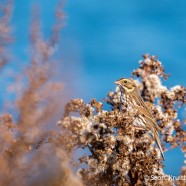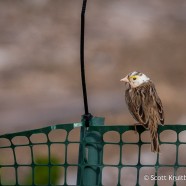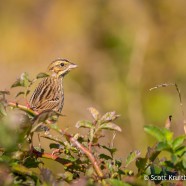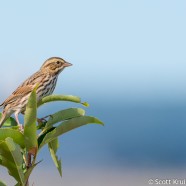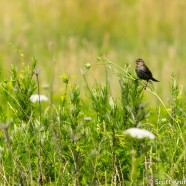Savannah Sparrow
This Savannah Sparrow is showing off some excellent fall and soon to be winter camouflage! Grasslands, fields, shrub and scrub, and beach habitats are some of the places to find them still moving through in late, small numbers, with others setting up their winter homes. Keep an eye out for the Ispwich Savannah Sparrow if you are on the Atlantic Coast. This subspecies of Savannah Sparrow breeds exclusively on Sable Island, Nova Scotia, and winters on similar sand dunes on the shoreline. It is noticeably paler and weighs approximately 50% more than most other Savannah Sparrow...
Read MoreLeucistic Savannah Sparrow
This appears to be a partially leucistic Savannah Sparrow, a migrant individual that I was surprised by yesterday morning. Leucism is when pigments are produced at less than normal levels or in an unexpected pattern. In this case many of the feathers on the head and throat do not have typical pigmentation. Interestingly the yellow patch on the face can still be seen, giving this unique bird an all the more fascinating look. Scott Kruitbosch Conservation & Outreach Coordinator
Read MoreSavannah Sparrow
Masses of Savannah Sparrows are still on the move right now, pushing through our fields, grasslands, shrublands, farmlands and other open areas with significant food supplies and enough room to hide. Autumn allows you to study so many individual birds that show us how much variance there can be within what we call a species.
Read MoreSavannah Sparrow
This Savannah Sparrow (Passerculus sandwichensis) was one of dozens of migrants of the species that I spotted this past weekend. Their numbers are increasing as they head south for the winter. As we go deeper into autumn we will see hundreds of them in fields, grasslands and farms across large open spaces in areas like Chautauqua County or coastal scrub and shrub habitat in locations such as Stratford Point. Get those Peterson Field Guides ready! They will not all be this easy to identify…
Read MoreRed-winged Blackbird Female
People often think of the Red-winged Blackbird strictly as a species of ponds, cattails and marshes, but they can be found in all sorts of old and wet fields, pastures, coastal grasslands and even golf courses with areas of water. Their ability to take to a sizable variety of habitats has helped them become one of the most abundant birds on the continent. Here we have a female who was vocalizing because of a nearby nest. In a couple of months they will be starting to form flocks and staging before heading south. While most of the species will leave our area some will push through the autumn...
Read More



